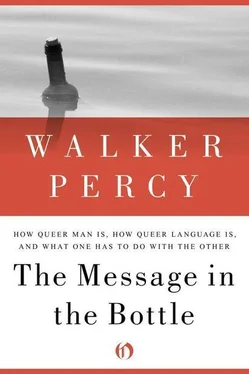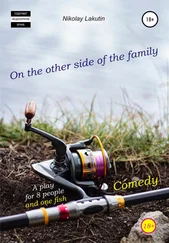At the subcultural, subassertory level of phenomena (physics, chemistry, biology), no antinomy occurs because the distinction between world event and intersubjective assertion is not violated. Physics lends itself without exception to the nonradical discipline in which you and I construe the world as a series of events expressible by assertions which are generically different from the events they assert.
At the cultural level, however, a further task is required of the method. It is required that an assertion be accepted not only as a true-or-false claim between scientists, to be proved or disproved, but as a phenomenon under investigation, to be ordered to other phenomena in the corpus of scientific knowledge. It is required that the assertions S is P and E =f ( C ), be fitted into the scheme of world events, event C → event E.
This is an impossible requirement however. An assertion is a real event but it is not a space-time event. The attempt must have one of two consequences: (1) The cultural assertion S is P (myth, language, science) is actually construed as a world event and its assertory character denied. (2) The cultural assertion S is P is accepted as an assertion, but not as a world event, as rather a true-or-false claim about world events.
The final result is an antinomy with scientists interpreting the same event in a contradictory fashion, as a world event and denying its assertory character, as an assertory event, a true-or-false claim, but refusing to examine it as such.
TOWARD A RADICAL ANTHROPOLOGY
When Socrates met Phaedrus on the banks of the Ilissus, the latter asked him if this was not the spot where, according to the myth, Boreas carried off fair Orithyia. Socrates replied that it was; when asked whether he believed it, he replied that he did not. Questioned further, he refused to speculate about the symbolic meaning of the myth, as the Sophists and Rhetoricians did when they theorized that the myth was in a sense true because she might have been blown off the cliff, and Boreas being the north wind, etc. “But I have no leisure at all for such pastimes, and the reason, my dear friend, is that as yet I cannot, as the Delphic precept has it, know myself. So it seems absurd to me that as long as I am in ignorance of myself, I should concern myself about such extraneous matters.”
Socrates might well have made the same objection to modern culturology. Cassirer, who quotes the above incident with approval, then goes on to do just what Socrates declines to do: search for meaning in the symbolic forms of myth. Indeed, Cassirer explicitly rejects the Delphic motto and so rules out the possibility of a radical anthropology. In Cassirer’s view, it is hopeless to attempt to fathom the human source of the symbolic forms of culture. “Philosophy has no choice but to reverse the direction of inquiry. Instead of taking the road back (to the nature of man), it must attempt to continue forward. If all culture is manifested in the creation of specific image-worlds, of specific symbolic forms, the aim of philosophy is not to go behind these creations, but rather to understand and elucidate their basic formative principle.”
As David Bidney has said, anthropology is divided into two main disciplines, physical anthropology, “which takes up such problems as the evolution and comparative anatomy of races …” and ethnology, which, “on the other hand, is said to be the study of human customs, institutions, artifacts, and products of mental exercise. The science of culture as practised is the study of these impersonal, superorganic, historical products of society and the ‘laws’ of their development.”
Put more bluntly, modern anthropology deals with man as a physical organism and with the products of man as a culture member, but not with man himself in his distinctive activity as a culture member. Ethnology has only recently gotten around to the study of man as personality affecting culture and being affected by culture.* Modern anthropology has been everything except an anthropology.
How may we deal scientifically with man considered precisely in those activities which distinguish him as a culture member? It is a perfectly legitimate scientific pursuit to study the material elements of culture as objective phenomena: the tools, the products of tools, the sounds of language, hunting, warfare, food gathering, the behavior of chiefs and shamans. It is perfectly legitimate to classify and study objectively languages, religions, societies. It is perfectly legitimate to write a sympathetic study of an island culture viewed from within as a way of life, an aesthetic pattern of existence. It is perfectly legitimate to write straight cultural history. But may we not also require of anthropology, the science of man, some assessment of that creature himself who makes culture possible?
The question which cannot be put off forever is not what is the nature of culture and what are the laws of culture but what is the ontological nature of the creature who makes the assertions of culture? How may we apply the scientific method in all its rigor and fruitfulness to man considered as a creature of culture? If one refuses to answer this question, one can hardly be called an anthropologist, perhaps anthropometrist or ethnographer, but not the scientist whose business it is to know man as such. A biologist, after all, is not afraid to speak about organisms.
The answer, I think, is not to be found in, a limitation or compromise of the scientific method but rather in making it a more radically useful instrument. To return to the tetradic structure of the scientific enterprise: a radical science must be willing to admit as eligible phenomena all real events, not merely space-time linkages. It must deal with assertory behavior as such; it cannot disqualify as a datum the very phenomenon of which it is itself a mode.
Such a requirement stems not from an “extra-scientific” position but from the exigency of the scientific method itself. The method must be able to give an account of its own elements and structure.
The functional method of the sciences is a nonradical method of knowing because, while it recognizes only functional linkages, it presupposes other kinds of reality, the intersubjectivity of scientists and their assertions, neither of which are space-time linkages and neither of which can be grasped by the functional method. Therefore, when the functional method is elevated to a total organon of reality and other cognitive claims denied, the consequence must be an antinomy, for a nonradical instrument is being required to construe the more radical reality which it presupposes but does not understand.
In order that progress be made toward a more radical science, it is necessary to take into account the framework within which the scientific method is mounted. In the case of anthropology, for example, it is necessary to realize that the “properties” of its subject, man, are of a more radical order of being than the operation of the functional method. Indeed, it is one of these “properties,” the assertory act of symbolization, which makes the scientific method possible. The assertory behavior of man, whether true or false, mythic or scientific, is on the same ontological plane as the inter-subjective enterprise of scientists. It is in the last analysis absurd to explain this activity entirely within the intersubjective framework, as not itself an intersubjective assertion but a space-time linkage grasped by an assertion. The attempt to account for cultural phenomena, language, myth, science, art, as events which are onto-logically “below” the activity of the theorist can only fall into an antinomy.
A radical anthropology must take account of ontological levels more radical than the scope of the functional method. Its subject, man, is not merely an organism, a social unit, a culture member (though he is all of these), but also he who, even as the scientist, makes assertions, is oriented not merely on a biological scale of need-satisfactions (though he is so oriented) but on a polar scale of truth-falsity, right-wrong, authenticity-inauthenticity, as well. A radical anthropology must be a normative science as well as a classificatory and functional science. This normative character, moreover, is not to be understood in the usual sense of “cultural values” lately acquired and relatively assessed but rather as constituting in the most radical sense the very mode of existence of the asserting creature of culture. The culture member is he who lives normatively.
Читать дальше












